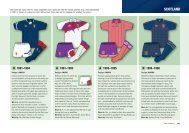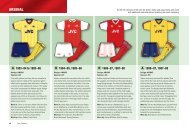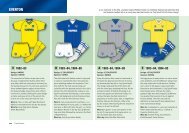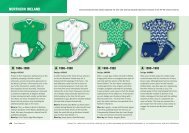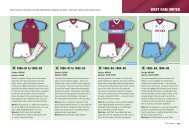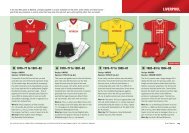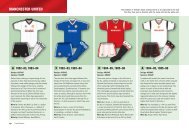England - True Colours Football Kits
England - True Colours Football Kits
England - True Colours Football Kits
Create successful ePaper yourself
Turn your PDF publications into a flip-book with our unique Google optimized e-Paper software.
Due to stringent advertising regulations the Admiral logos were missing from the<br />
<strong>England</strong> strips worn during the 1980 European Championship finals in Italy.<br />
ENGLAND<br />
H<br />
1974–1980<br />
A<br />
1974–1981<br />
H<br />
1980–1983<br />
A<br />
1981–1983<br />
Design: ADMIRAL<br />
<strong>England</strong>’s traditional plain and simple white<br />
shirt and navy shorts underwent a radical<br />
change in 1974 (the start of Don Revie’s reign<br />
as manager) with The FA’s innovative deal with<br />
Admiral. A collar was introduced along with red<br />
and royal blue sleeve stripes. The shorts were<br />
now also royal blue and a manufacturer’s logo<br />
was included on an <strong>England</strong> outfield strip for<br />
the first time. The 70s were not a good time for<br />
the <strong>England</strong> team and this strip is one of the<br />
few donned by the side in recent years that<br />
was never worn in a major tournament.<br />
Worn in: A storming 5–1 thrashing of Scotland<br />
in the 1975 Home Internationals. Also worn in<br />
a tight 4–3 win over Denmark in the Euro 80<br />
qualifying tournament.<br />
Worn by: Trevor Francis, Steve Coppell.<br />
Design: ADMIRAL<br />
The customary English red away shirt also<br />
sported the new and controversial Admiral<br />
embellishments, with blue and white trim<br />
complimenting the red and mirroring the<br />
design of the home. The white shorts were<br />
also able to be worn with the home shirt on<br />
the rare occasion <strong>England</strong> required an all-white<br />
strip. Several different fabrics were used over<br />
the years to construct the jersey, including a<br />
mesh-like material which helped players stay<br />
cool in hot temperatures. Ron Greenwood<br />
replaced Revie as manager in 1977.<br />
Worn in: A 1–1 draw with Brazil in a 1978<br />
Wembley friendly. Also worn in a good 4–1<br />
away win against Finland in a 1978 World Cup<br />
final qualifier.<br />
Worn by: Kevin Keegan, Trevor Brooking.<br />
Design: ADMIRAL<br />
Admiral all but disappeared from the British<br />
football world in 1980 due to financial<br />
problems, but somehow still persevered as<br />
<strong>England</strong> kit supplier. This outfit was even more<br />
controversial than their first effort, and<br />
featured large blue and red shoulder panels<br />
accompanied by a slim V-neck. The shorts<br />
remained royal blue and were now trimmed<br />
with an intricate arrangement of red, white and<br />
blue on each leg. The socks remained the<br />
same as those from the previous kit.<br />
Worn in: Three games during the Spain 1982<br />
World Cup: wins over Czechoslovakia (2–0) and<br />
Kuwait (1–0), along with a 0–0 draw with Spain<br />
in the second stage.<br />
Worn by: Phil Neal, Dave Watson, Paul Mariner,<br />
Mick Mills, Terry McDermott, Tony Woodcock.<br />
Design: ADMIRAL<br />
Launched a year after the unveiling of<br />
Admiral’s second home kit, this next away shirt<br />
once again reflected the design of the home.<br />
Two versions of the shirt were worn: one as<br />
illustrated here, and a second design that<br />
included an additional white band in the<br />
shoulder panel, placed above the <strong>England</strong><br />
badge and Admiral logo. Again, the shorts and<br />
socks could be mixed and matched between<br />
the home and away kits.<br />
Worn in: A superb 3–1 win over France (who<br />
also donned their away kit) during the 1982<br />
World Cup finals that included Bryan Robson’s<br />
27 second goal – one of the fastest ever in the<br />
World Cup. Also worn in a 0–0 draw with old<br />
rivals West Germany in the second stage.<br />
Worn by: Ray Wilkins, Phil Thompson.<br />
<strong>True</strong> <strong>Colours</strong> 2 177
As well as dominating <strong>England</strong>’s domestic top flight, Umbro also supplied strips for all four home<br />
international sides: <strong>England</strong>, Scotland, Wales and Northern Ireland, between 1990 and 1994.<br />
ENGLAND<br />
H<br />
1993–1994<br />
A<br />
1994–1995<br />
H<br />
1995–1996<br />
A<br />
1996–1997<br />
Design: UMBRO<br />
Any shirt that followed the prestige of the Italia<br />
90 Umbro effort had a lot to live up to.<br />
Premiered in the first fixture of 1993 (a 6–0 win<br />
over San Marino in a World Cup qualifier) this<br />
outfit had one of the shortest reigns of any<br />
<strong>England</strong> home strip. The jersey’s collar<br />
included a miniature replica of the <strong>England</strong><br />
crest – the primary version of which was made<br />
slightly larger giving more space for the three<br />
lions. The fabric incorporated a zig-zag shadow<br />
pattern along with an abstracted series of<br />
Umbro logos. The strip was worn throughout<br />
<strong>England</strong>’s dismal 1994 World Cup qualifying<br />
campaign.<br />
Worn in: A 2–2 draw with the Netherlands in a<br />
1993 World Cup qualifier.<br />
Worn by: Alan Shearer, Graeme Le Saux.<br />
Design: UMBRO<br />
A new red design was launched in 1994 with<br />
Terry Venables now <strong>England</strong> manager following<br />
the resignation of Graham Taylor. It was<br />
another short-lived strip and was created from<br />
a much deeper red (officially described as<br />
‘wine’) than had been worn previously. It<br />
incorporated a large navy floppy collar and a<br />
complex shadow print arrangement. Like many<br />
kits of the era, it also included long, loosefitting<br />
shorts. The strip accompanied some<br />
decidedly mixed fortunes for the side: a win, a<br />
defeat and the 1995 game against the Republic<br />
of Ireland that was abandoned due to crowd<br />
trouble.<br />
Worn in: The 5–0 rout of Greece in a home<br />
friendly (1994).<br />
Worn by: Gary Neville, Matthew Le Tissier.<br />
Design: UMBRO<br />
The mid-90s found Umbro experimenting with<br />
unorthodox colour schemes throughout their<br />
kit roster. In <strong>England</strong>’s case, red was discarded<br />
and replaced by turquoise – giving a totally<br />
fresh look to the strip. The badge and new<br />
text-only Umbro logo were placed centrally,<br />
and a new cleverly constructed collar and neck<br />
design introduced. Faint shadow stripes<br />
adorned the fabric and dynamic white and<br />
turquoise shards trimmed the shorts. The strip<br />
will forever be remembered for the incredible<br />
Euro 96 tournament in <strong>England</strong>.<br />
Worn in: The unforgettable 2–0 win over<br />
Scotland thanks to some Gazza magic and the<br />
jaw-dropping 4–1 humiliation of the<br />
Netherlands (both Euro 96 finals).<br />
Worn by: Teddy Sheringham, Jamie Redknapp.<br />
Design: UMBRO<br />
As the side prepared to host the Euro 96 finals,<br />
this unconventional new away kit was unveiled<br />
– the first non-red <strong>England</strong> primary change<br />
outfit for many years. With the popularity of<br />
replica jerseys at an all-time high, the shirt was<br />
one of the first to be designed as a leisure item<br />
as well as a piece of functional football<br />
apparel. Officially ‘indigo blue’, the two-tone<br />
hue was perceived by many to be more of a<br />
enigmatic grey colour. Intricate fabric printing<br />
and white pinstripes adorned the jersey.<br />
‘<strong>England</strong>’ text was added beneath the FA crest.<br />
Worn in: The epic and emotional penalties<br />
defeat against Germany in the semi-final of<br />
Euro 96, after the match finished 1–1.<br />
Worn by: Steve Stone, Steve McManaman,<br />
Gareth Southgate, Paul Ince, Darren Anderton.<br />
<strong>True</strong> <strong>Colours</strong> 2 181



